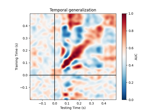mne.decoding.PSDEstimator#
- class mne.decoding.PSDEstimator(sfreq=6.283185307179586, fmin=0, fmax=inf, bandwidth=None, adaptive=False, low_bias=True, n_jobs=None, normalization='length', *, verbose=None)[source]#
Compute power spectral density (PSD) using a multi-taper method.
- Parameters:
- sfreq
float The sampling frequency.
- fmin
float The lower frequency of interest.
- fmax
float The upper frequency of interest.
- bandwidth
float The bandwidth of the multi taper windowing function in Hz.
- adaptivebool
Use adaptive weights to combine the tapered spectra into PSD (slow, use n_jobs >> 1 to speed up computation).
- low_biasbool
Only use tapers with more than 90% spectral concentration within bandwidth.
- n_jobs
int Number of parallel jobs to use (only used if adaptive=True).
- normalization‘full’ | ‘length’
Normalization strategy. If “full”, the PSD will be normalized by the sampling rate as well as the length of the signal (as in Nitime). Default is
'length'.- verbosebool |
str|int|None Control verbosity of the logging output. If
None, use the default verbosity level. See the logging documentation andmne.verbose()for details. Should only be passed as a keyword argument.
- sfreq
See also
Methods
fit(epochs_data, y)Compute power spectral density (PSD) using a multi-taper method.
fit_transform(X[, y])Fit to data, then transform it.
transform(epochs_data)Compute power spectral density (PSD) using a multi-taper method.
- fit(epochs_data, y)[source]#
Compute power spectral density (PSD) using a multi-taper method.
- Parameters:
- Returns:
- selfinstance of
PSDEstimator The modified instance.
- selfinstance of
